Trench Art – Creating Beauty from the Horrors of War
What is trench art, and what can art produced by prisoners of war, soldiers, and civilians teach us about the visual languages of conflict? In this article, we will be exploring trench art as an important form of documenting the emotions, context, and artistic expression of those who witness conflicts. We will also take a look at the history and emergence of trench art, primarily during the First World War, as well as a few examples of trench art that remain today. Keep reading to discover more about this relevant and crucial art form!
Contents
Contextualizing WW1 Trench Art: The Great War
What is trench art and which countries from the First World War participated in trench art? The Great War, which was also known as World War I, was one of the most devastating conflicts that shook the world between 1914 and 1918. Particularly on the Western Front, trench warfare became a long-standing symbol of the brutality, violence, and stagnation caused by conflict. As such, the art form known as trench art emerged across the globe as a response to the realities of war and the traumatic experiences faced by soldiers, civilians, and prisoners.

Numerous individuals from various nations across the globe engaged in trench art and used materials that were available at their disposal to create handcrafted objects. These objects held patriotic and personal significance to the soldiers and artists who created them, while also gaining commercial value. Trench art encompassed a variety of visual expressions, from engraved shells to complex sculptures, as a response to the conflict.
To understand any artwork, one needs to examine the context in which it was also produced. The artists, who were mostly soldiers, experienced unimaginable horrors on the battlefront. These include the constant fear and threat from enemies, as well as the grim and harsh living conditions of the trenches. Despite the chaotic environment, trench art emerged as a coping mechanism for those affected by the war. Through the mediums of handmade crafts, poetry, sketches, drawings, and other art forms, soldiers were able to psychologically escape the trauma of their lived realities.
The creation of trench art was not confined to specific countries. Rather, it was a widespread art practice among all those engaged in the war.
Some of the most dominant countries that produced trench art in World War I include France, the United Kingdom, Germany, the United States, Belgium, and other Central Powers and allies. France was one of the primary battlegrounds for the Western Front, which saw extensive trench warfare. As such, French soldiers and civilians gathered materials that were available to them on the battlefields and began producing trench art.
In the United Kingdom, British soldiers who served on the Western Front produced trench art through workshops such as the Omega Workshops, which were established by artists like Roger Fry and Duncan Grant. Similarly, in Germany, both the civilians and soldiers were involved in creating trench art to reflect the differing perspectives of the opposing side on the Western Front. Meanwhile, the many significant battles that occurred in Belgium encouraged soldiers to produce trench art, most notably inspired by the Battle of Passchendaele. Finally, while the United States entered the war in the later stages, many American soldiers produced trench art with a distinctly American character, drawing from American culture. Across the globe, many Allied and Central power countries, including Russia and Italy, also participated in producing trench art.
Defining WW1 Trench Art
So, what exactly was trench art? Trench art refers to any decorative artwork that was created using debris or remnants and materials derived from the war by soldiers or civilians of any country caught in the conflict. Within the context of World War I, trench art included a variety of objects, with the most notable type of trench art being artillery shell trench art. This type of trench art involved the repurposing of artillery shells by soldiers who would transform them into complex artworks. The repurposed artillery shells would be used to create new decorative vases, as well as engraved shell casings to show off the resourcefulness and innovation that emerged from the conflict and trauma of the war.
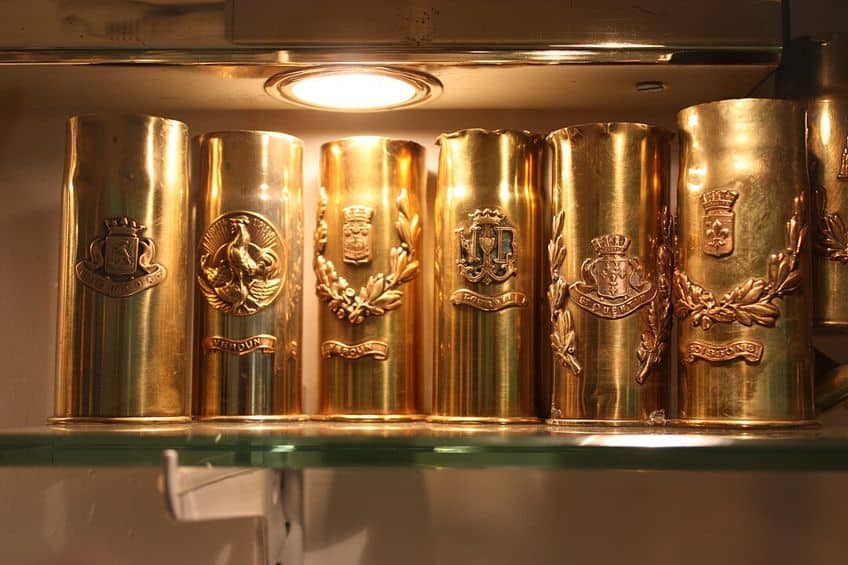
While the underlying subject of artillery shell art seems particularly dark, considering its context, it does provide us with insight into the emotions of the soldiers at the time, as well as their use of materials that were directly linked to armed conflict and its effect on the human psyche. While most materials were sourced from the conflict and were materials that were found on the battlefront, there were other controversial forms of trench art such as a letter opener that was crafted from the bone of a human arm and gifted to Franklin Roosevelt.
In a twisted way, the bone letter as an example of trench art reflects the distortion of the human mind and the impact of war on soldiers to have the ability to view human remains as sources for creating art.
One will not be surprised to learn that trench art extended beyond the First World War and throughout the Napoleonic Wars. While trench art saw its heyday in World War I, the term was also used to describe any kind of conflict-produced souvenir that was created by service personnel in the Second World War. It is thus of interesting study to observe the transformation of the term “trench art” as a “souvenir” in the context of a conflict.
The Four Types of Trench Art
In trench art, four different categories shed light on the context and significance of each type of trench artwork. Below we will examine the four different types of trench art so that you can begin to distinguish what makes each of these categories different from each other.
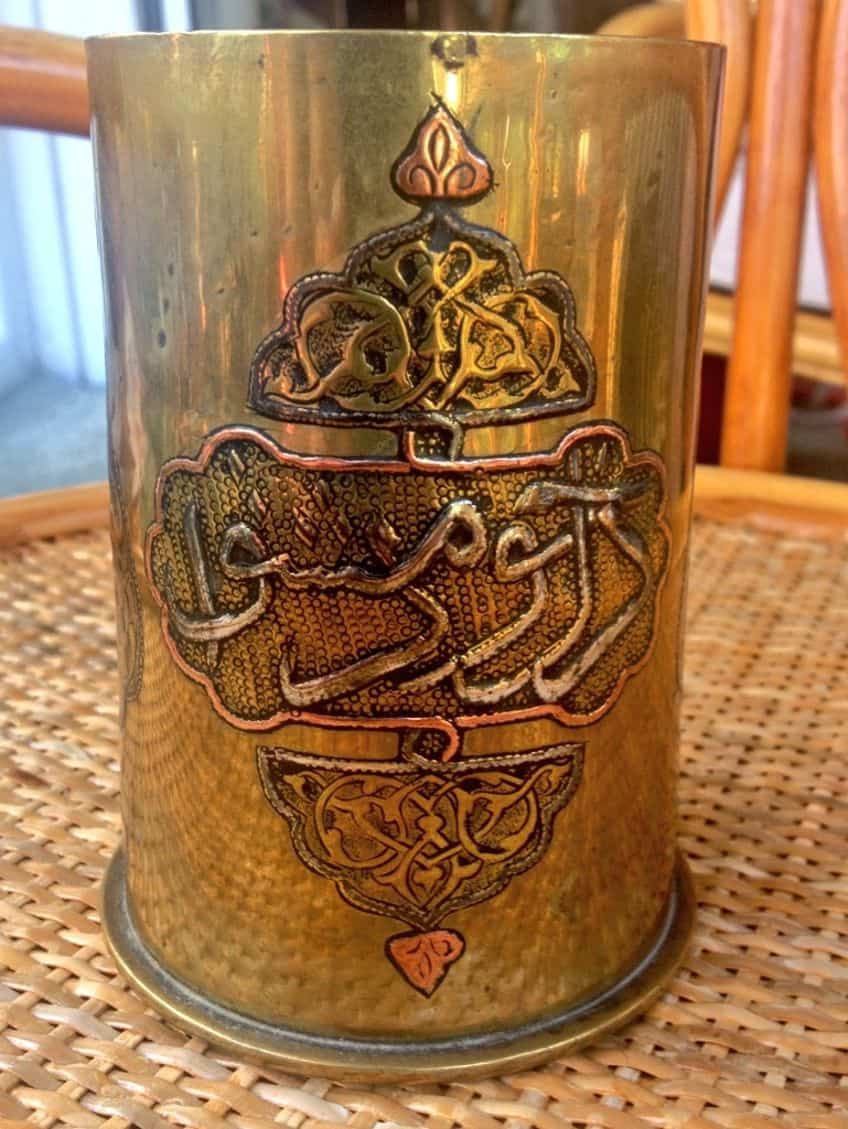
Trench Art Created by Soldiers
Objects and artworks created and crafted by soldiers in the war make up one of the largest categories of trench art since there is much evidence to prove that trench art was created in the trenches during the war. A memoir from World War I titled With a Machine Gun to Cambrai (1969) by George Coppard narrates the production process of his trench art. He described the process involving his uniform buttons, which he pressed into a clay floor in the trenches and poured molten lead from the shrapnel over it to create a cast of the regimental crest. Trench art that was created by soldiers also included chalk carvings, as well as contemporary postcards with the carvings from the trenches and rocky dug-out shelters.
During this time, soldiers used art to cope with the traumatic experience of the war and thus also became artists in their own right, producing other smaller items from knives to rings across the quieter areas of the trenches.

Art was thus a form of therapeutic engagement for soldiers, which was also noted in the therapeutic embroidery from the British military located in Egypt. There are photographs of the British military soldiers, who have been documented creating embroidery and sewing for Syrian refugees. The establishment of the Bradford Khaki Handicrafts Club in 1918 is another example of this type of creative “occupational therapy” for those who returned from trench warfare in France.
Trench Art by Prisoners and Interned Civilians
Trench art was also produced by interned civilians and prisoners of war. Many prisoners of war. Created decorated objects and artworks using their free time despite the limited resources. The intention behind the artworks created by prisoners of war was to express their intention of trading their finished product for privileges such as food and money.
This second type of trench art shows a different side to the art form in terms of its use and the intention behind the artwork, extending to its commercial power, as an item of trade for prisoners of war to gain access to basic resources.

Art thus became not only a coping mechanism for those who had a certain status in the war but also highly valued by those who required art and the means to produce such artworks, as a means to survive. In 1930, A B Baker, W.A.A.C. published a book titled Every Man at War, where he reflects on the prisoners of war and his role in terms of receiving these artworks and carvings that the German prisoners produced. He described the prisoners as friendly men.
Trench Art by Civilians
This category of trench art was produced primarily by civilians who were in the vicinity of the conflict zone, as well as the objects and artworks produced by their families at home. One of the most famous examples of trench art created by civilians was the printed cotton flour sacks, which formed part of the staple packaging sent by the Commission for Relief in Belgium in 1914.
This organization was set up by the United States and these flower bags would be returned with embroidered and painted designs by the Belgians, which also included motifs, flags, and dates that cannot be viewed at the Herbert Hoover Museum.
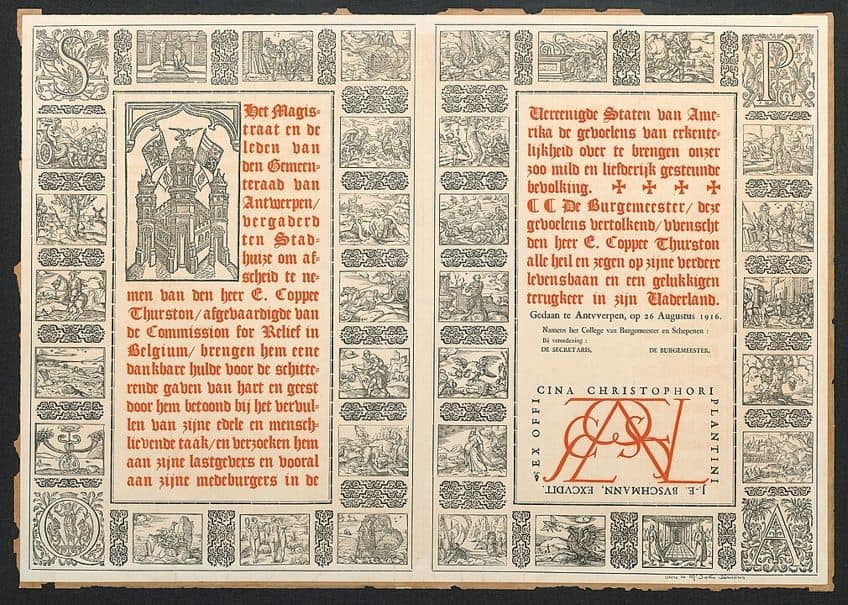
Another remnant of trenchant produced by civilians in France was the embroidered postcards that found their way into the cottage industry. Some of the motifs depicted on these postcards included regimental crests, national symbols, and patriotic flags that were produced in the millions throughout the war. In the post-war period, when shattered communities tried to reclaim their economic stability, new markets emerged in the form of tourists and pilgrims. This enabled artisans to recycle 20 years’ worth of equipment, discarded debris, and other remnants of the war into souvenirs for tourists.
Commercial Trench Art
While the different types of categories all progress towards increasingly commercial functions, commercial trench art emerged after the war since tons of materials that were sold by the government were transformed into souvenirs, as explained in the previous category. This also involved the use of ships and shipbreaking, which enabled artists to transform the wood of ships into small barrels, boxes, brass plaques, and other souvenirs to sell to tourists.
Ships that had been used in significant battles, such as the Battle of Jutland, were also broken down and recycled into various objects and items.
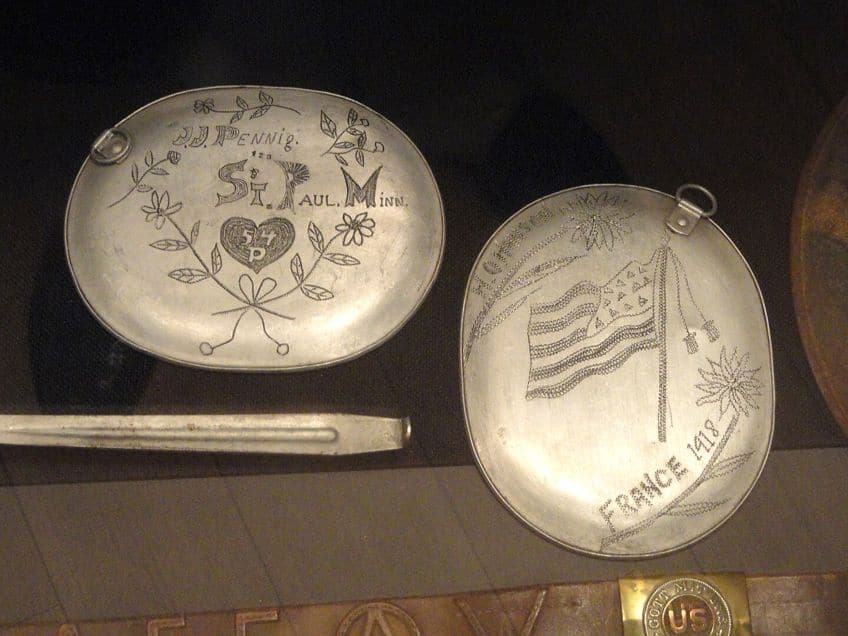
The Primary Characteristics of Trench Art
What makes trench art stand out from other forms of art that reflect on the idea of conflict and the atrocities of war? One of the main aspects of trench art is that it was produced using an improvisation technique or approach by soldiers who were actively engaged in the war. This means that these artworks were created in real-time, within the context they directly address, referring to trench warfare. This is perhaps one of the most important characteristics of trench art since it was produced in a raw and improvised manner.
Most trench artworks were thus crafted in makeshift workshops and created directly within trenches, making it an art form that served a utilitarian and artistic purpose.
One can also look at the characteristics of trench art through the specific production of artillery shell trench art, which featured intricate engravings and the addition of other materials like leather or wood to enhance the final artwork. One can also study the styles incorporated in trench art since they reflected on the conditions of the war and incorporated elements from the conflict such as personal sentiments, personal and collective traumas, militarism, and patriotism.
The Weapon As Artwork in Trench Art
In a book by Nicholas J. Saunders titled Trench Art: Materialities and Memories of War (2011), Saunders describes the ironies of metal artworks in trench art concerning shell case engravings that contained motifs that one would not expect. These ranged from romantic Art Nouveau-styled figures to flowers, pastoral motifs, and other decorative designs since the 1890s.
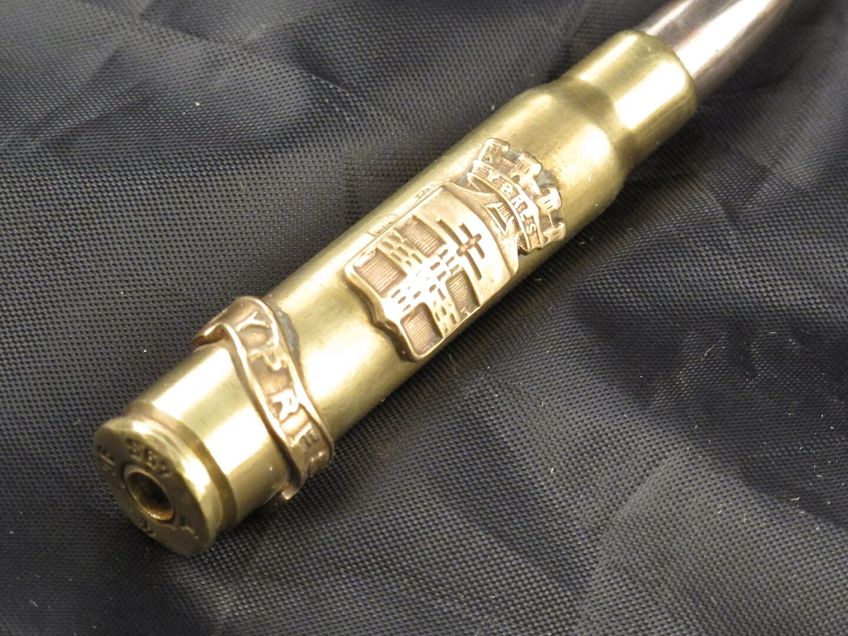
This brings us to the concept witnessed widely in trench art since its context enabled the use of weapons as mediums to be transformed into artworks. The notion of the weapon as artwork in trench art highlights the beauty of transformation in the ability to change objects of death such as bullets into works of art, for admiration, appreciation, and documentation of personal suffering. The wastefulness of World War I provided an abundance of excess materials for soldiers and artists to use and meld into artworks. Trench artworks are therefore said to be small trophies for survivors of the war, whose plight forced them to turn to art and invent small creations from which to draw hope.
Exploring the Symbolism and Significance of Trench Art
The creation of trench art holds immense symbolism in that it represents the adaptability, resourcefulness, and resilience of the human spirit. Additionally, one can also admire the beauty in adversity, especially in times of conflict when those who are caught in the crossfire and those who are also on the battlefront can artistically articulate themselves through powerful messages of hope, survival, and transformation. Trench art is not just a memento of World War I.
It can also be used as a patriotic symbol, which provides individuals with a sense of control over their environment, despite the tumultuous conditions in which they live.
Trench Art in Contemporary Conflicts
While the distant sense of time with which we interpret and review conflicts of the past may distort our understanding of war as an immediate threat, one can also understand conflict in its contemporary setting. In the recent decade, there have been numerous conflicts across the globe that highlight the fact that art does not have to be produced in a highly publicized war context for it to have a profound impact. While trench art is considered to be a historical phenomenon, one can look at the concept of producing art as a response to conflict in the current period, as a tool for raising awareness and communicating with the world about such issues. In times of upheaval, it is important to reflect on the role of the artist, writer, and creative cultural worker, who produces these artworks in times of political and social strife, and how such artworks can be used to transform the community and world around us.
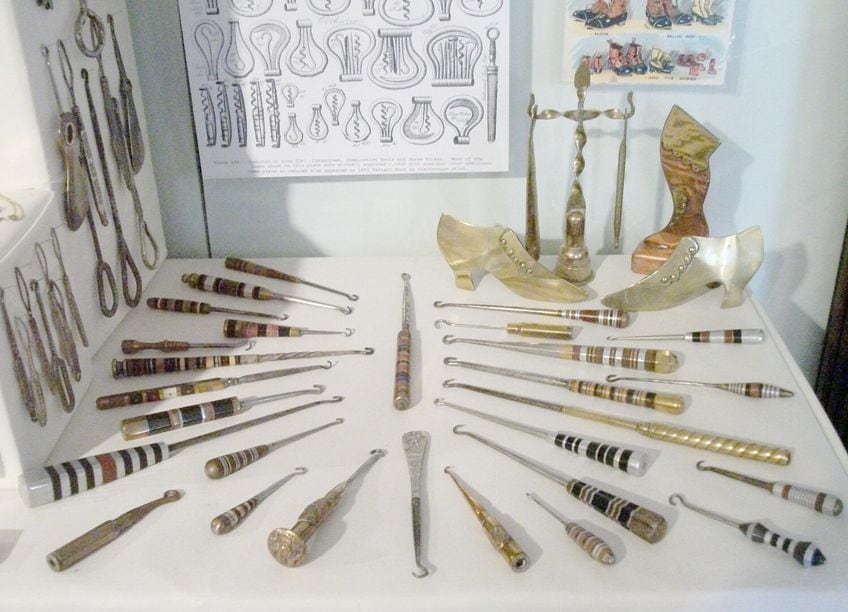
Today, most museums dedicated to military events contain some type of trench art as a curio. However, it is viewed as more than just a souvenir and memory of the war since it is also associated with the way that soldiers, civilians, and prisoners processed the war using art. In the contemporary era, the way that historians, anthropologists, and archaeologists view trench art has been significantly transformed since it is no longer tied to only the hands of enthusiastic trench art collectors. Rather, the art form is a significant teaching point for how art emerged in environments of conflict and what such artworks can teach art about the adaptability and resilience of people in modern cases of conflict.
Displays of trench art can be seen at the Imperial War Museums in the United Kingdom, as well as the National World War I Museum in Kansas City, the Museum of the Great War in France, and the Hooge Crater Museum.
Examples of Trench Art
Now that you have an idea of the history and background of trench art from World War I, you can review some of the surviving examples of trench art that offer unique insight into the artistry of war-time artists.
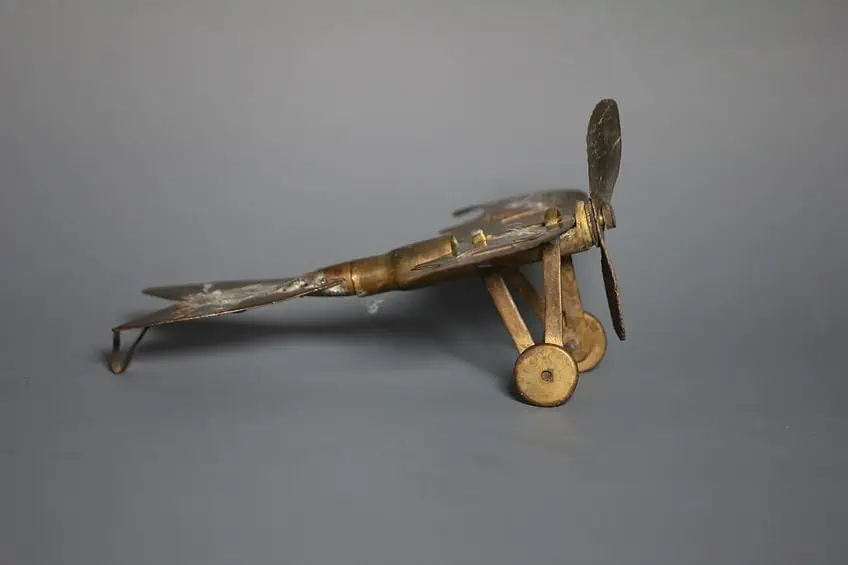
Shell Case Jug (c. 1914 – 1918) by Sapper Southgate
| Artist Name | Sapper E Southgate (Royal Engineers) |
| Date | c. 1914 – 1918 |
| Medium | Copper alloy |
| Dimensions (cm) | 10.4 x 20.8 x 17.2 |
| Where It Is Housed | Imperial War Museums, London, United Kingdom |
This copper alloy 18-pounder Mark II trench jug was created by Sapper E. Southgate in World War I, while he monitored an underground telephone exchange in the Ypres district. A well-preserved trench artwork, this shell case was also inscribed with the battle honors of the 25th division and featured the cap badge of Royal Engineers.
The handle was fashioned from two German 7.92mm rifle rounds.
British Tapestry; Belt (c. 1914 – 1918) by Unknown Artist
| Artist Name | Unknown artist |
| Date | c. 1914 – 1918 |
| Medium | Multicolored textile |
| Dimensions (cm) | 87 |
| Where It Is Housed | Imperial War Museums, London, United Kingdom |
This colorful textile belt is also housed at the Imperial War Museum and was fashioned using two leather straps, D-shaped buckles, and purple felt. The belt also contains the stitched names “W.A.HOLLAND” and “H.M.S. MINOTAUR” across it with geometric borders on the edges of the belt. While it is unclear who produced the belt, its owner, W. A. Holland served at the Battle of Jutland in 1916.
The title “H.M.S. MINOTAUR” refers to an armored cruiser that Holland also served in after the Battle of Jutland.
Bullet Crucifix (c. 1918) by Unknown Artist
| Artist Name | Unknown artist |
| Date | c. 1918 |
| Medium | Metal |
| Dimensions (cm) | 4.4 x 15.5 x 8.3 |
| Where It Is Housed | Imperial War Museums, London, United Kingdom |
Housed at the Imperial War Museum in the United Kingdom, this bullet crucifix is one of the most famous trench artworks from World War I. The upright cross was created from two cartridges on a circular base with the upper cartridge cut off at the bottom and attached to the base of the lower cartridge. Bullets were also used to create the arms of the cross with the cartridges themselves composed of .303-inch British cartridge cases and 8mm French bullets. The trench artwork is said to be a product of the post-war era that was perhaps offered on sale to visitors of the battlefield.
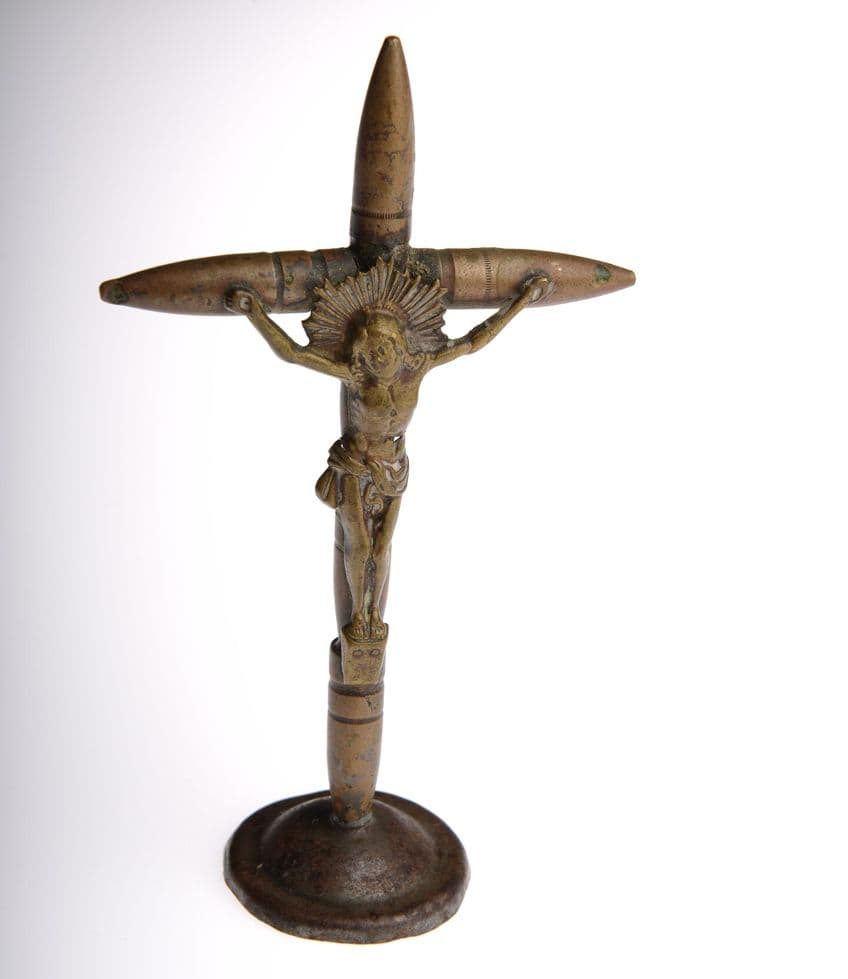
The conception of the artwork reflects that it was inspired by the religious art of the First World War since its religious imagery was juxtaposed with the symbolism of the icons used; the resurrection and the paraphernalia of death. Apart from engraved casings and metal sculptures, soldiers in the war also created their rings, lighters, matchbox covers, and shell cases to add a level of art and in a sense, humanity, to a context that was very much at odds with humanity.
The value of trench art holds immense significance since it is a testament to the innovation, creativity, and resilience of those who faced the tribulations of World War I. Beyond the historical and artistic significance of these artifacts, one can also find appreciation and solace in the ability of the human spirit to produce art in dark moments such as war. Conflict-produced art also offers insight into the emotional landscape of war through the stories, symbols, and narratives embedded in each trench artwork.
Frequently Asked Questions
What Is Trench Art?
The term trench art is used to describe artistic products of war produced during Modern Warfare, most notably in World War I. Trench art also includes decorative objects and items created by all parties involved in conflict. Trench art tackles themes related to the emotional impact of war, as well as the context in which it was produced and the context of the materials used to produce trench art. This type of artwork was produced primarily by servicemen during the First World War.
Who Created Trench Art?
Art that was produced in the trenches during World War One was known as trench artwork and was created primarily by servicemen. These servicemen created trench art to pass the time when they were not actively engaged in battle. Trench art exists beyond the realm of fine art, since its production was directly connected to the experience of war. Trench art was also produced by prisoners of war and civilians who relied on these artworks to earn an income or to exchange these objects for other resources as a means to survive.
What Are the Characteristics of Trench Art?
The main characteristics of trench art involved the use of recycled materials from the war, including spent bullets, shell casings, and other materials that were available to soldiers on the battlefield. These recycled goods came in all shapes and sizes and were often made up of discarded artillery shell cases and rifle cases. Civilians, soldiers, and prisoners of war created trench art together with other materials such as wood, leather, and bone to produce unique artworks.
What Was the Purpose of Trench Art?
The purpose of trench artworks was primarily for soldiers to pass their time during the war, as well as a therapeutic activity to process the traumatic events of the time. While trench art is usually associated with the First World War, there have been other instances in war history, where soldiers, civilians, and prisoners of war created trench art for their commercial value as trade items and to sell as souvenirs to tourists.
Jordan Anthony is a Cape Town-based film photographer, curator, and arts writer. She holds a Bachelor of Art in Fine Arts from the University of the Witwatersrand, Johannesburg, where she explored themes like healing, identity, dreams, and intuitive creation in her Contemporary art practice. Jordan has collaborated with various local art institutions, including the KZNSA Gallery in Durban, the Turbine Art Fair, and the Wits Art Museum. Her photography focuses on abstract color manipulations, portraiture, candid shots, and urban landscapes. She’s intrigued by philosophy, memory, and esotericism, drawing inspiration from Surrealism, Fluxus, and ancient civilizations, as well as childhood influences and found objects. Jordan is working for artfilemagazine since 2022 and writes blog posts about art history and photography.
Learn more about Jordan Anthony and about us.
Cite this Article
Jordan, Anthony, “Trench Art – Creating Beauty from the Horrors of War.” artfilemagazine – Your Online Art Source. November 28, 2023. URL: https://artfilemagazine.com/trench-art/
Anthony, J. (2023, 28 November). Trench Art – Creating Beauty from the Horrors of War. artfilemagazine – Your Online Art Source. https://artfilemagazine.com/trench-art/
Anthony, Jordan. “Trench Art – Creating Beauty from the Horrors of War.” artfilemagazine – Your Online Art Source, November 28, 2023. https://artfilemagazine.com/trench-art/.


